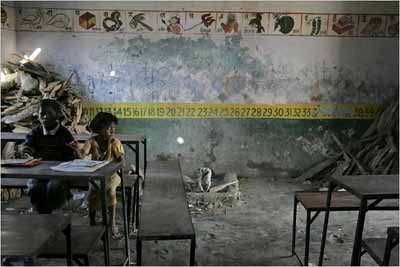I enjoyed
looking at some of the influences behind
The Namesake last week, and I've started to look at some of
Mira Nair's older films -- including one that I hadn't seen before,
The Perez Family.
The Perez Family is a film adaptation of a
novel by the same name by Christine Bell. It's the story of a family separated at the time of the Cuban revolution, which has the potential to be reunited because of the
Mariel boatlift of 1980. The boatlift brought more than 100,000 Cuban refugees to the United States, with full approval of both Castro and the U.S. government.
Though Nair's
Perez Family doesn't always work dramatically (there are some implausible elements in the story, and some of the actors struggle with their Cuban accents), the film does have some very smart moments, and a theme that resonates closely with Nair's other films, including especially
Mississippi Masala and
The Namesake. The connection is this: all three are in essence
diaspora stories, about the trauma of leaving behind one life, and the excitement and ambivalence entailed in embracing a new culture. As with
Mississippi Masala (and even
The Namesake, to some extent), the moment of leaving is wrapped up in a historical (and personal) trauma -- a trauma named "Idi Amin" in one case, and "Fidel Castro" in another. In all three films (as well as Nair's adaptation of
My Own Country, made for TV), that new country is United States, which is far less transparent to outsiders than Americans like to think.
In
The Perez Family, the first film Nair made after the breakthrough critical and commercial success of
Mississippi Masala, Nair does throw in some specifically
South Asian elements as a running leitmotif in what is otherwise an essentially Cuban diaspora story. The most obvious of these is the immigration official in Miami, played by
Ranjit Chowdhry, the actor who was also memorable as "Mundu" in Deepa Mehta's
Fire. As a heavily accented immigrant himself, Chowdhry's INS official serves as a friend and guide to Marisa Tomei's Dorita Perez, as she learns how to adapt to American society -- a process that begins, of course, with navigating the immigration bureaucracy itself. There is something curious and strange about an Indian immigrant serving as the "model" for the Americanization of a Cuban ("I am going to have to tell you what to do!" he says, at one point), but it works quite well in the film, even when it's just there for comic relief. It's Chowdhry's character who has to reveal to Dorita (Tomei), for instance, that John Wayne, for Dorita the very embodiment of a sexy, heroic America, is in fact dead. It's also his "hint" that families will get sponsored more quickly than singles that leads Dorita to stick to Juan (Molina), and eventually also contrive a "son" (a street kid) as well as a "father" to move things forward.
There are some highly memorable, symbolism-laden bits of cinematography in the film. The opening shot is a slow pan across a beach in Cuba, pre-revolution. Elegantly dressed men and women in white suits sit at tables, drinking cocktails, as a waiter (again, formally dressed) makes his way through. The music, traditional Cuban
Son (the music for the film as a whole is done by the excellent Arturo Sandoval, incidentally), adds an air of "Old Havana" nostalgia. The pan ends on the headlights and grill of a Studebaker-type car -- symbolizing, without a single line of dialogue, the way in which the Cuban story was in some sense
always about the United States, even before the Cubans left home (i.e., the Revolution was in some sense a reaction against the American economic exploitation of the island...). After the Studebaker, Nair cuts to Alfred Molina, who is watching as his young wife, Carmela, wades into the water with their daughter. She's leaving -- this is a dream sequence -- but he'll be left behind. The film doesn't provide too much by way of backstory, but there is a hint that Molina's character, Juan Raul Perez, was a sugar plantation owner who spent 20 years in Castro's prisons, while his wife and daughter were able to escape to Miami. (Perhaps Christine Bell's novel spells out in greater detail how they were originally separated. The only lines that makes their way into the dialogue of the film are things like, "I burned my sugar plantation, rather than give it to him [Castro]"; and "I sent her away for the weekend, and it turned into 20 years.")
The shot of the young Carmela wading into the water is echoed nicely a bit later in the film, as Alfred Molina and Marisa Tomei's characters, who meet one another on the boatlift to Miami itself, approach Key West. Tomei's Dorita is thrilled to be reaching the U.S. -- she is the kind of immigrant who embraces with gusto the new, while Molina is too traumatized by the past to let go of it -- and dives into the water, fully clothed. Molina, again, is left behind, watching.
I won't say too much about the plot of the film as it goes forward for fear of spoiling it for those readers who might not have seen it. Suffice it to say that it follows the drift of other diasporic/immigrant stories: Juan Perez (Molina) has to find his wife and daughter in Miami after 20 years of separation, overcoming certain obstacles, while also making sense of his new relationship with the sensual, adventurous
"Marielita" Dorita (Marisa Tomei's performance is turned up to "11" in this film; she owns every scene she's in).
Though it tilts too far into melodrama at times,
The Perez Family is worth seeing, especially for Nair fans, who will certainly appreciate the overlaps and parallels with her other films here. (I might also add that fans of Cuban music will enjoy the excellent soundtrack, as will fans of Marisa Tomei, who gives one of her best performances here.)
